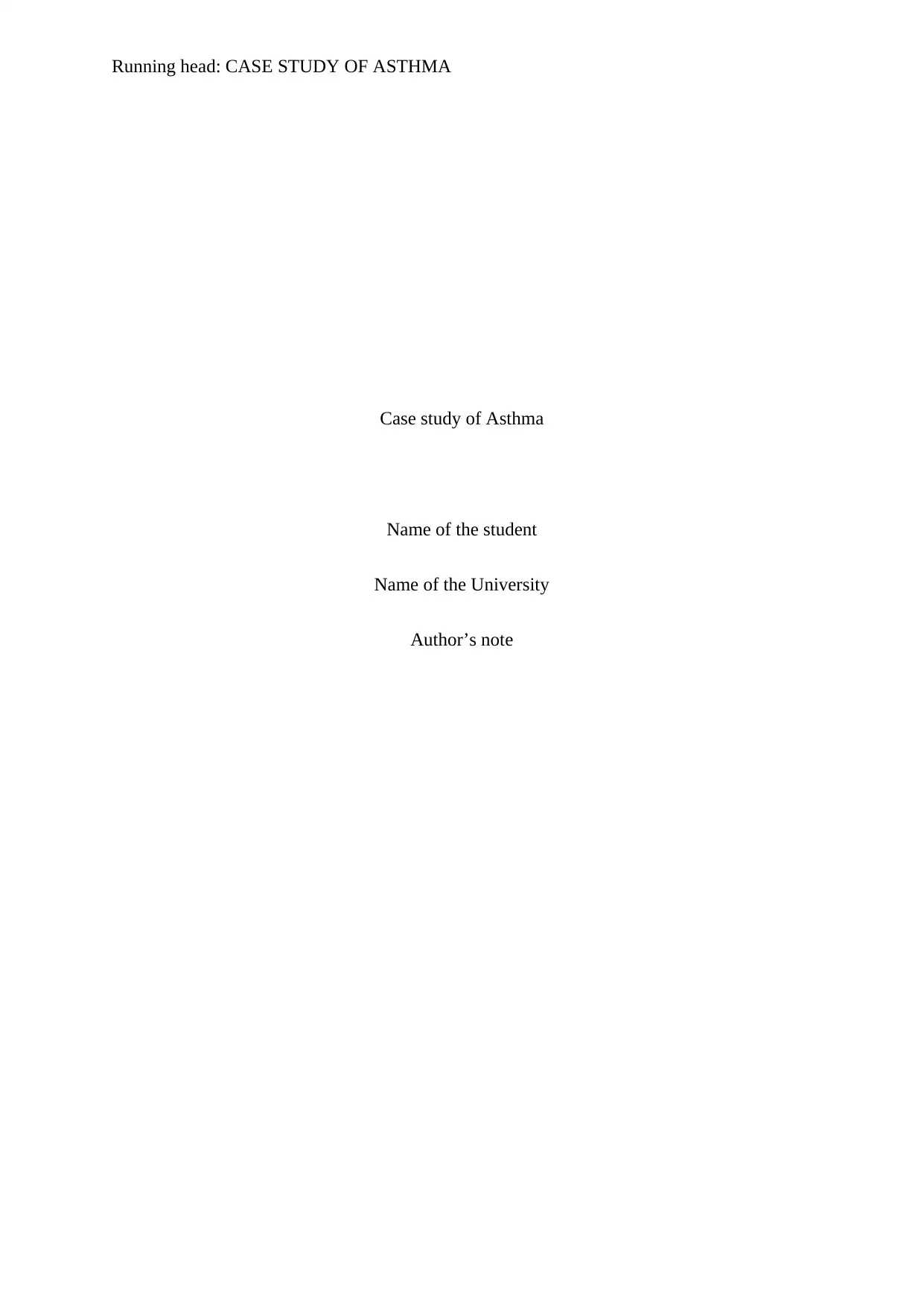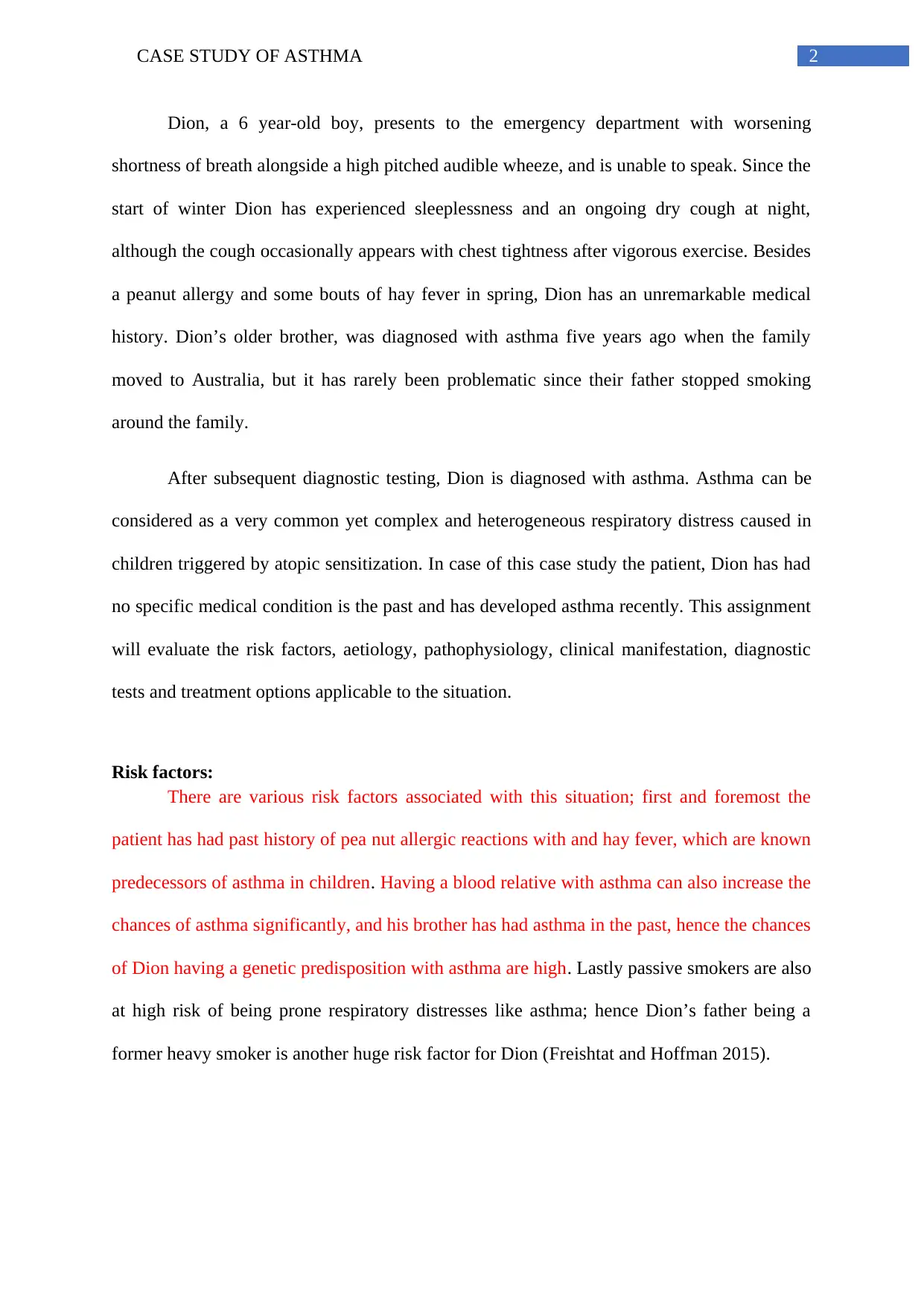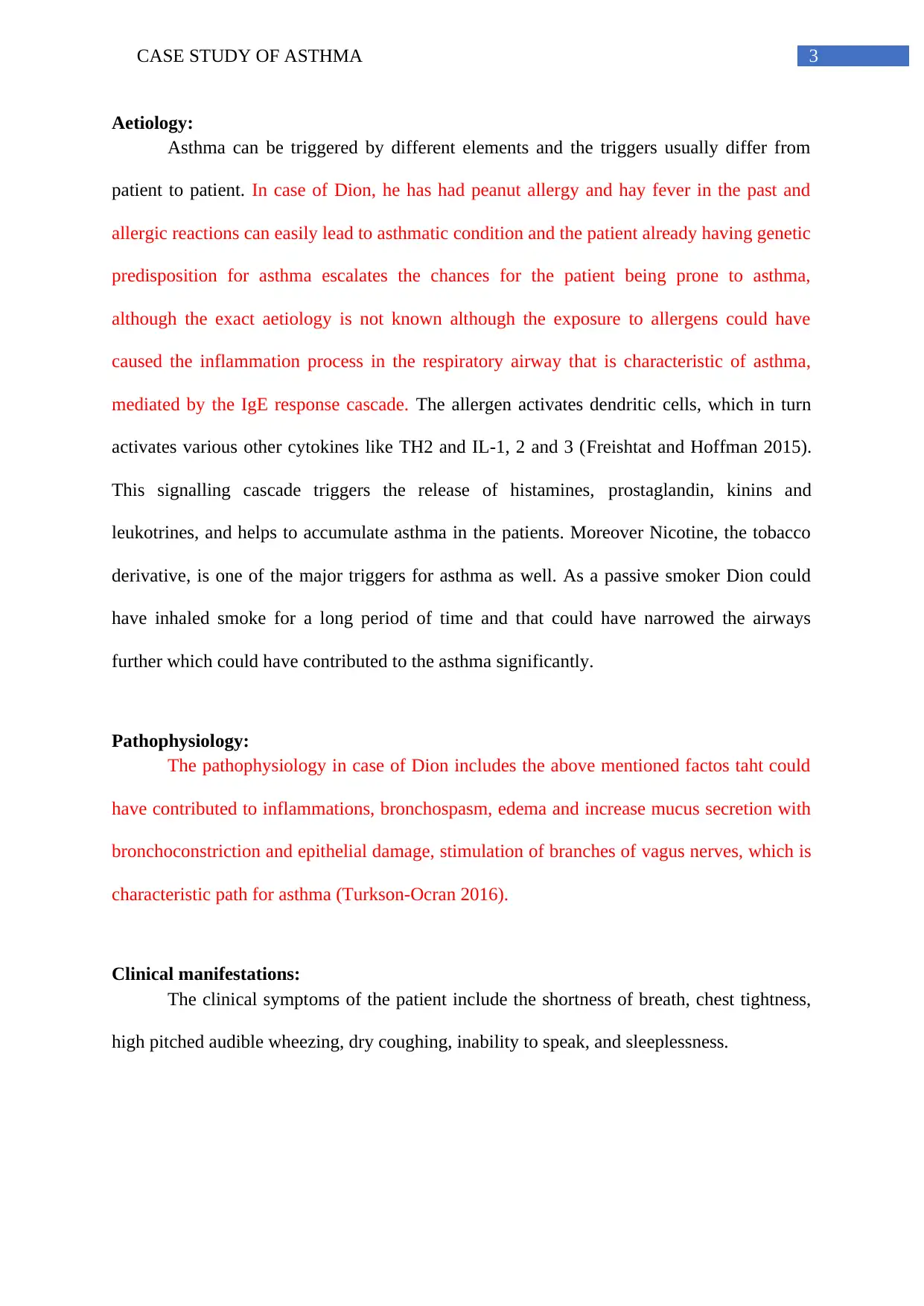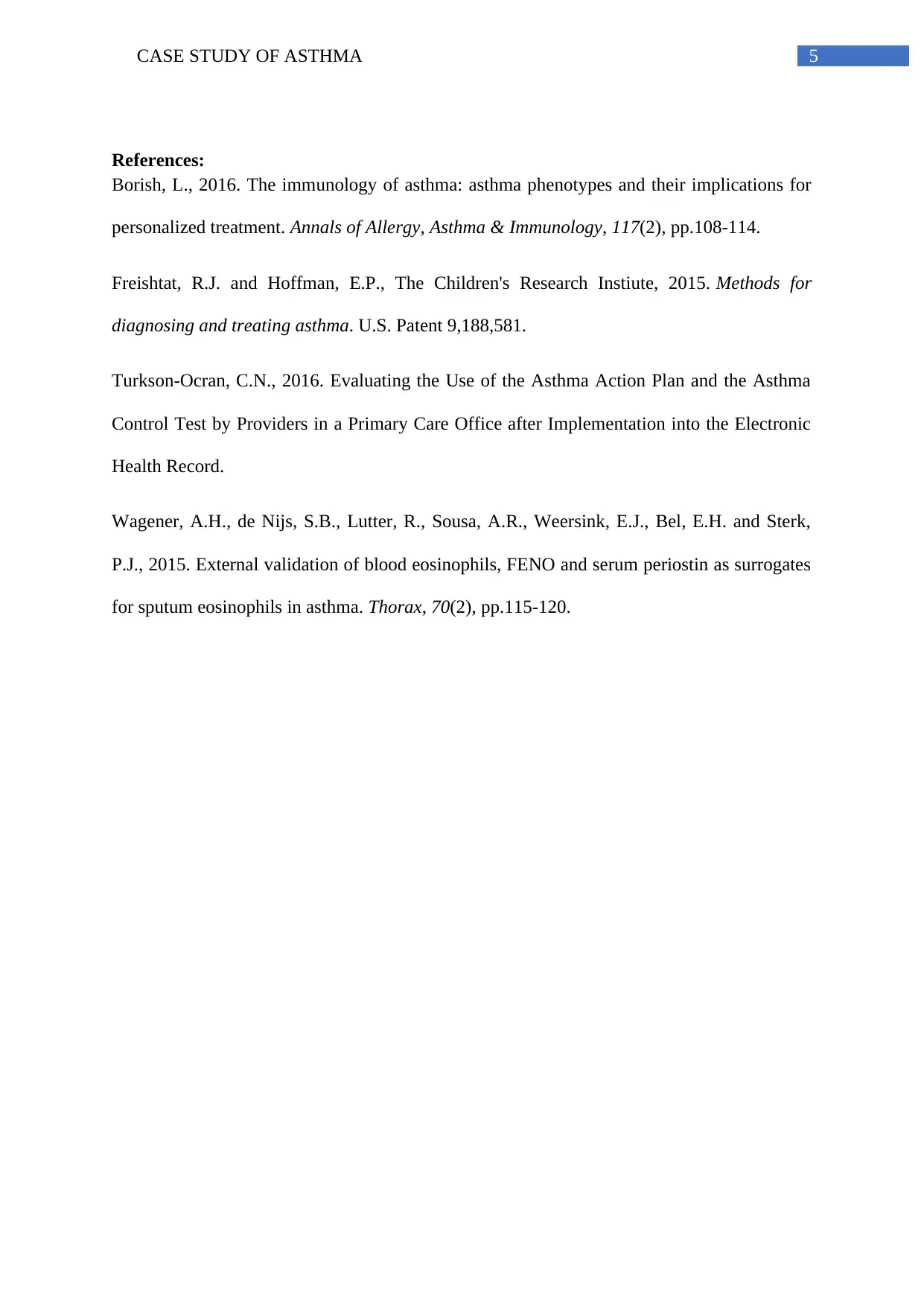Case Study Analysis: Dion's Asthma - Risk, Diagnosis, and Treatment
VerifiedAdded on 2020/03/04
|6
|929
|51
Case Study
AI Summary
This case study focuses on a 6-year-old boy, Dion, who presents to the emergency department with asthma symptoms. The assignment evaluates the risk factors, including past allergies and family history, aetiology, and pathophysiology, highlighting inflammation and bronchospasm. It details clinical manifestations like shortness of breath and wheezing, along with diagnostic tests such as spirometry. The study also explores treatment options, including pharmacological interventions like short-acting beta2 agonists and inhaled corticosteroids, and emphasizes patient and family education. The analysis references relevant medical literature to support the findings and recommendations for managing the patient's condition.

Running head: CASE STUDY OF ASTHMA
Case study of Asthma
Name of the student
Name of the University
Author’s note
Case study of Asthma
Name of the student
Name of the University
Author’s note
Paraphrase This Document
Need a fresh take? Get an instant paraphrase of this document with our AI Paraphraser

1CASE STUDY OF ASTHMA
Table of Contents
Risk factors:...............................................................................................................................2
Aetiology:...................................................................................................................................2
Pathophysiology:........................................................................................................................3
Clinical manifestations:..............................................................................................................3
Diagnostic test:...........................................................................................................................3
Treatment:..................................................................................................................................3
References:.................................................................................................................................5
Table of Contents
Risk factors:...............................................................................................................................2
Aetiology:...................................................................................................................................2
Pathophysiology:........................................................................................................................3
Clinical manifestations:..............................................................................................................3
Diagnostic test:...........................................................................................................................3
Treatment:..................................................................................................................................3
References:.................................................................................................................................5

2CASE STUDY OF ASTHMA
Dion, a 6 year-old boy, presents to the emergency department with worsening
shortness of breath alongside a high pitched audible wheeze, and is unable to speak. Since the
start of winter Dion has experienced sleeplessness and an ongoing dry cough at night,
although the cough occasionally appears with chest tightness after vigorous exercise. Besides
a peanut allergy and some bouts of hay fever in spring, Dion has an unremarkable medical
history. Dion’s older brother, was diagnosed with asthma five years ago when the family
moved to Australia, but it has rarely been problematic since their father stopped smoking
around the family.
After subsequent diagnostic testing, Dion is diagnosed with asthma. Asthma can be
considered as a very common yet complex and heterogeneous respiratory distress caused in
children triggered by atopic sensitization. In case of this case study the patient, Dion has had
no specific medical condition is the past and has developed asthma recently. This assignment
will evaluate the risk factors, aetiology, pathophysiology, clinical manifestation, diagnostic
tests and treatment options applicable to the situation.
Risk factors:
There are various risk factors associated with this situation; first and foremost the
patient has had past history of pea nut allergic reactions with and hay fever, which are known
predecessors of asthma in children. Having a blood relative with asthma can also increase the
chances of asthma significantly, and his brother has had asthma in the past, hence the chances
of Dion having a genetic predisposition with asthma are high. Lastly passive smokers are also
at high risk of being prone respiratory distresses like asthma; hence Dion’s father being a
former heavy smoker is another huge risk factor for Dion (Freishtat and Hoffman 2015).
Dion, a 6 year-old boy, presents to the emergency department with worsening
shortness of breath alongside a high pitched audible wheeze, and is unable to speak. Since the
start of winter Dion has experienced sleeplessness and an ongoing dry cough at night,
although the cough occasionally appears with chest tightness after vigorous exercise. Besides
a peanut allergy and some bouts of hay fever in spring, Dion has an unremarkable medical
history. Dion’s older brother, was diagnosed with asthma five years ago when the family
moved to Australia, but it has rarely been problematic since their father stopped smoking
around the family.
After subsequent diagnostic testing, Dion is diagnosed with asthma. Asthma can be
considered as a very common yet complex and heterogeneous respiratory distress caused in
children triggered by atopic sensitization. In case of this case study the patient, Dion has had
no specific medical condition is the past and has developed asthma recently. This assignment
will evaluate the risk factors, aetiology, pathophysiology, clinical manifestation, diagnostic
tests and treatment options applicable to the situation.
Risk factors:
There are various risk factors associated with this situation; first and foremost the
patient has had past history of pea nut allergic reactions with and hay fever, which are known
predecessors of asthma in children. Having a blood relative with asthma can also increase the
chances of asthma significantly, and his brother has had asthma in the past, hence the chances
of Dion having a genetic predisposition with asthma are high. Lastly passive smokers are also
at high risk of being prone respiratory distresses like asthma; hence Dion’s father being a
former heavy smoker is another huge risk factor for Dion (Freishtat and Hoffman 2015).
⊘ This is a preview!⊘
Do you want full access?
Subscribe today to unlock all pages.

Trusted by 1+ million students worldwide

3CASE STUDY OF ASTHMA
Aetiology:
Asthma can be triggered by different elements and the triggers usually differ from
patient to patient. In case of Dion, he has had peanut allergy and hay fever in the past and
allergic reactions can easily lead to asthmatic condition and the patient already having genetic
predisposition for asthma escalates the chances for the patient being prone to asthma,
although the exact aetiology is not known although the exposure to allergens could have
caused the inflammation process in the respiratory airway that is characteristic of asthma,
mediated by the IgE response cascade. The allergen activates dendritic cells, which in turn
activates various other cytokines like TH2 and IL-1, 2 and 3 (Freishtat and Hoffman 2015).
This signalling cascade triggers the release of histamines, prostaglandin, kinins and
leukotrines, and helps to accumulate asthma in the patients. Moreover Nicotine, the tobacco
derivative, is one of the major triggers for asthma as well. As a passive smoker Dion could
have inhaled smoke for a long period of time and that could have narrowed the airways
further which could have contributed to the asthma significantly.
Pathophysiology:
The pathophysiology in case of Dion includes the above mentioned factos taht could
have contributed to inflammations, bronchospasm, edema and increase mucus secretion with
bronchoconstriction and epithelial damage, stimulation of branches of vagus nerves, which is
characteristic path for asthma (Turkson-Ocran 2016).
Clinical manifestations:
The clinical symptoms of the patient include the shortness of breath, chest tightness,
high pitched audible wheezing, dry coughing, inability to speak, and sleeplessness.
Aetiology:
Asthma can be triggered by different elements and the triggers usually differ from
patient to patient. In case of Dion, he has had peanut allergy and hay fever in the past and
allergic reactions can easily lead to asthmatic condition and the patient already having genetic
predisposition for asthma escalates the chances for the patient being prone to asthma,
although the exact aetiology is not known although the exposure to allergens could have
caused the inflammation process in the respiratory airway that is characteristic of asthma,
mediated by the IgE response cascade. The allergen activates dendritic cells, which in turn
activates various other cytokines like TH2 and IL-1, 2 and 3 (Freishtat and Hoffman 2015).
This signalling cascade triggers the release of histamines, prostaglandin, kinins and
leukotrines, and helps to accumulate asthma in the patients. Moreover Nicotine, the tobacco
derivative, is one of the major triggers for asthma as well. As a passive smoker Dion could
have inhaled smoke for a long period of time and that could have narrowed the airways
further which could have contributed to the asthma significantly.
Pathophysiology:
The pathophysiology in case of Dion includes the above mentioned factos taht could
have contributed to inflammations, bronchospasm, edema and increase mucus secretion with
bronchoconstriction and epithelial damage, stimulation of branches of vagus nerves, which is
characteristic path for asthma (Turkson-Ocran 2016).
Clinical manifestations:
The clinical symptoms of the patient include the shortness of breath, chest tightness,
high pitched audible wheezing, dry coughing, inability to speak, and sleeplessness.
Paraphrase This Document
Need a fresh take? Get an instant paraphrase of this document with our AI Paraphraser

4CASE STUDY OF ASTHMA
Diagnostic test:
The most important diagnostic test that the patient must undergo includes the
spirometry test along with airway challenge test, FBC tests and study of familial history of
asthma (Freishtat and Hoffman 2015).
Treatment:
The management of asthma in case of Dion could be done pharmacologically with
immunomodulators and antikeuketrines. This includes the short acting beta2 agonist such as
salbutamol and inhaled corticosteroids which can be extremely effective in minimizing the
clinical manifestation of asthma by relieving the bronchoconstriction that leads to shortness
of breaths (Borish 2016). The patient and his family should also be educated about asthma
and its preventative management in detail.
Diagnostic test:
The most important diagnostic test that the patient must undergo includes the
spirometry test along with airway challenge test, FBC tests and study of familial history of
asthma (Freishtat and Hoffman 2015).
Treatment:
The management of asthma in case of Dion could be done pharmacologically with
immunomodulators and antikeuketrines. This includes the short acting beta2 agonist such as
salbutamol and inhaled corticosteroids which can be extremely effective in minimizing the
clinical manifestation of asthma by relieving the bronchoconstriction that leads to shortness
of breaths (Borish 2016). The patient and his family should also be educated about asthma
and its preventative management in detail.

5CASE STUDY OF ASTHMA
References:
Borish, L., 2016. The immunology of asthma: asthma phenotypes and their implications for
personalized treatment. Annals of Allergy, Asthma & Immunology, 117(2), pp.108-114.
Freishtat, R.J. and Hoffman, E.P., The Children's Research Instiute, 2015. Methods for
diagnosing and treating asthma. U.S. Patent 9,188,581.
Turkson-Ocran, C.N., 2016. Evaluating the Use of the Asthma Action Plan and the Asthma
Control Test by Providers in a Primary Care Office after Implementation into the Electronic
Health Record.
Wagener, A.H., de Nijs, S.B., Lutter, R., Sousa, A.R., Weersink, E.J., Bel, E.H. and Sterk,
P.J., 2015. External validation of blood eosinophils, FENO and serum periostin as surrogates
for sputum eosinophils in asthma. Thorax, 70(2), pp.115-120.
References:
Borish, L., 2016. The immunology of asthma: asthma phenotypes and their implications for
personalized treatment. Annals of Allergy, Asthma & Immunology, 117(2), pp.108-114.
Freishtat, R.J. and Hoffman, E.P., The Children's Research Instiute, 2015. Methods for
diagnosing and treating asthma. U.S. Patent 9,188,581.
Turkson-Ocran, C.N., 2016. Evaluating the Use of the Asthma Action Plan and the Asthma
Control Test by Providers in a Primary Care Office after Implementation into the Electronic
Health Record.
Wagener, A.H., de Nijs, S.B., Lutter, R., Sousa, A.R., Weersink, E.J., Bel, E.H. and Sterk,
P.J., 2015. External validation of blood eosinophils, FENO and serum periostin as surrogates
for sputum eosinophils in asthma. Thorax, 70(2), pp.115-120.
⊘ This is a preview!⊘
Do you want full access?
Subscribe today to unlock all pages.

Trusted by 1+ million students worldwide
1 out of 6
Related Documents
Your All-in-One AI-Powered Toolkit for Academic Success.
+13062052269
info@desklib.com
Available 24*7 on WhatsApp / Email
![[object Object]](/_next/static/media/star-bottom.7253800d.svg)
Unlock your academic potential
Copyright © 2020–2025 A2Z Services. All Rights Reserved. Developed and managed by ZUCOL.





